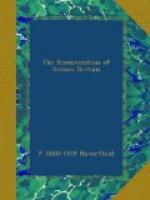Such is, in brief, the positive evidence, archaeological, linguistic, and historical, which illustrates the Romanization of Britain. The conclusions which it allows seem to be two. First, and mainly: the Empire did its work in our island as it did generally on the western continent. It Romanized the province, introducing Roman speech and thought and culture. Secondly, this Romanization was perhaps not uniform throughout all sections of the population. Within the lowlands the result was on the whole achieved. In the towns and among the upper class in the country Romanization was substantially complete—as complete as in northern Gaul, and possibly indeed even more complete. But both the lack of definite evidence and the probabilities of the case require us to admit that the peasantry may have been less thoroughly Romanized. It was covered with a superimposed layer of Roman civilization. But beneath this layer the native element may have remained potentially, if not actually, Celtic, and in the remoter districts the native speech may have lingered on, like Erse or Manx to-day, as a rival to the more fashionable Latin. How far this happened actually within the civilized lowland area we cannot tell. But we may be sure that the military region, Wales and the north, never became thoroughly Romanized, and Cornwall and western Devon also lie beyond the pale (p. 21). Here the Britons must have remained Celtic, or at least capable of a reversion to the Celtic tradition. Here, at any rate, a Celtic revival was possible.
CHAPTER VIII
THE SEQUEL, THE CELTIC REVIVAL IN THE LATER EMPIRE
So far we have considered the province of Britain as it was while it still remained in real fact a province. Let us now turn to the sequel and ask how it fits in with its antecedents. The Romanization, we find, held its own for a while. The sense of belonging to the Empire had not quite died out even in sixth-century Britain. Roman names continued to be used, not exclusively but freely enough, by Britons. Roman ’culture words’ seem to occur in the later British language, and some at least of these may be traceable to the Roman occupation of the island. Roman military terms appear, if scantily. Roman inscriptions are occasionally set up. The Romanization of Britain was plainly no mere interlude, which passed without leaving a mark behind.[1] But it was crossed by two hostile forges, a Celtic revival and an English invasion.
[Footnote 1: Much of the ornamentation used by post-Roman Celtic art comes from Roman sources, in particular the interlaced or plaitwork, which has been well studied by Mr. Romilly Allen. But how far it was borrowed from Romano-British originals and how far from similar Roman-provincial work on the Continent, is not very clear. (See p. 36.)]




